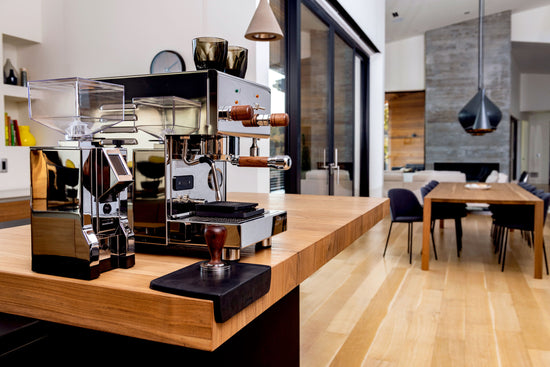Dual Boiler vs Heat Exchanger Espresso Machines

There are two very popular options for home baristas seeking a machine capable of handling any espresso drink: heat exchangers and dual boilers. Both categories are host to fantastic machines, but the trick is figuring out which is right for you. In general, it comes down to choosing between power and precision.
When we talk about power we’re usually talking about the power of a machine's heating elements and the capacity of its boilers – after all, most of the functionality of an espresso machine relies on a steady stream of hot water or steam. More power means more shots pulled in a row and/or faster steaming of milk.
Precision almost always comes in the form of temperature control. Pulling your shots at the right temperature makes all the difference in the world. A machine that can produce hot water at a super consistent temperature will allow you to pull the same delicious shot time after time.
So, how do you tell if a machine is more focused on power or precision? Let’s start with two machines that offer a great example of this contrast: the Profitec Pro 300, a dual boiler, and the ECM Mechanika V Slim, a heat exchanger.
The Pro 300 has a PID on its brew boiler which allows it to control brew temperature very precisely, keeping water within a degree of the target temperature. When you’re brewing with coffees of different roast levels it makes a huge difference to be able to target a fitting temperature. You’d be surprised how much smoother a dark roast can be when brewed at 195°F vs 200°F. A PID gives you this ability which is a big part of what makes the Pro 300 such a compelling offering for home baristas with a penchant for single origins and experimentation. When it comes to power the Pro 300 has a relatively compact steam boiler. For most who want this machine, it’s enough that the 300 is capable of producing a few cappuccinos back to back with no issue. If you’re a big latte fan or want to serve a crowd, the Pro 300 isn’t going to be your best bet.

The Mechanika, on the other hand, delivers power in spades. It has a huge 2.2L steam boiler – larger than machines that cost almost twice as much. As a heat exchanger, it also uses this boiler to heat water headed to the group head for brewing. Having a single large boiler means that the Mechanika produces an absurd amount of steam power for its size. If you like lattes or want to whip up a dozen cappuccinos for your friends the Mechanika won’t blink twice. The thermal mass of that boiler means that you’ll also never have to worry about running out of hot water for brewing. Deceptive power aside, the Mechanika does not have a dedicated brew boiler or a PID. This means that the temperature of water you get from the group head is going to vary by a few degrees over the course of your shot. After a cooling flush it’ll always stay within the proper range for coffee, but targeting a specific temperature just isn’t possible. Each shot is bound to be slightly different from the last. If you plan on making use of all that milk, that might not matter to you.

In the realm of sub $2000 espresso machines, this choice between power and precision plays a pivotal role in the decision-making process of any home barista. It is worth noting, though, that it is perfectly possible to get the best of both worlds if you’re not willing to make any sacrifices.
Premium dual boiler machines like the LUCCA M58, ECM Synchronika, or La Marzocco Linea Mini have large, powerful steam boilers in combination with PID’d brew boilers providing power and precision in equal measure.
If you're leaning towards a heat exchanger, we cover PIDs in Heat Exchangers in another short video.